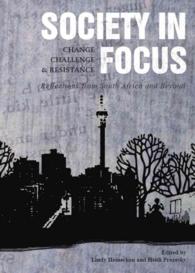- ホーム
- > 洋書
- > 英文書
- > Architecture
Full Description
More than Buildings studies the buildings typology in Portuguese cities and their relationship with the program (the way in which it responds to a function), the territory where it is integrated and with time and the way in which built forms evolve.
The book is structured around a set of key theoretical texts that highlight the potential of knowledge about typology (and its specific formal characteristics) in the production of new architectural objects. In this sense, the book has a didactic value based on the theoretical synthesis it produces, which allows it to expose certain spatial and formal attributes of the typologies and thus constitute a reference for new processes of architectural production. The method of analysis and decomposition of the case studies presented in each chapter provide a useful reading and interpretation key for different readers. The typology should be understood as a reference in the act of designing, demonstrating how to understand the elementary formal and spatial principles. For the municipal authorities, or other political decision-makers, the book will enable them to interpret the value of typology and its relevance in the production of cities. This data could be useful, for example, in planning actions that aim at preserving or converting urban areas of architectural value.
The book will be relevant to readers within an academic framework and in the professional field engaged in work around architecture, cities, planning, and conservation.
Contents
List of figures
List of contributors
Acknowledgements
Introduction
Sérgio Padrão Fernandes, João Silva Leite, Carlos Dias Coelho
1. The invention of an Atlas of buildings
Carlos Dias Coelho
Part I . PROGRAMME
2. Urban Blocks made up by Collective Housing
Rui Justo
3. Churches. Portuguese 16th-18th Century Uncanny buildings: Rules and Exceptions
Paulo Pereira
4. Agricultural Support Units: Buildings to Structure the Rural Territory
Gilberto Carlos
Part II . CONTEXT
5. Urban Buildings!
Sérgio Padrão Fernandes
6. Passage Buildings. An interface to intimacy.
João Silva Leite
7. Infrastructure steps in the city.
Pablo Villalonga Munar
Part III . TIME
8. Convents reUsed. Three transformation processes
Miguel Freitas Silva
9. An imPerfect Buildings. Espírito Santo Hospital in Évora.
Pedro Martins
10. Ruinology. About wrecks, ruins and forms in industrial decommissioned buildings
Stefanos Antoniadis
11. Buildings Metabolism. From pre-existence to urban regeneration.
Júlia Beltran Borràs
Trajectories
Carlos Dias Coelho, Sérgio Padrão Fernandes, João Silva Leite
Index








